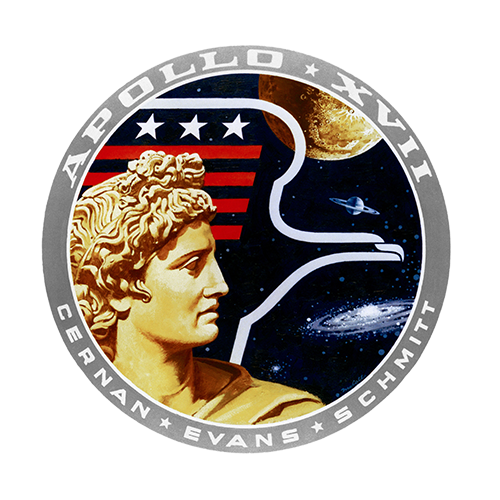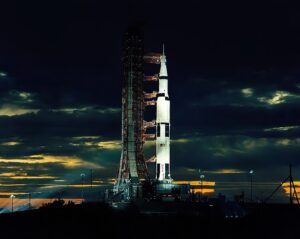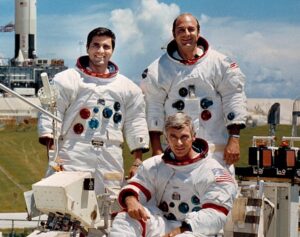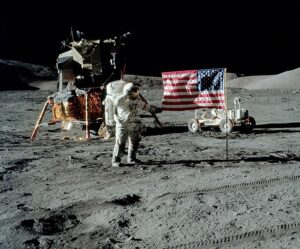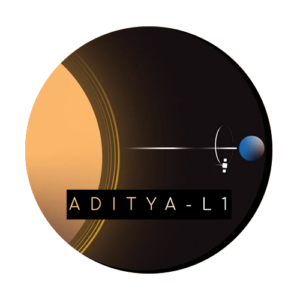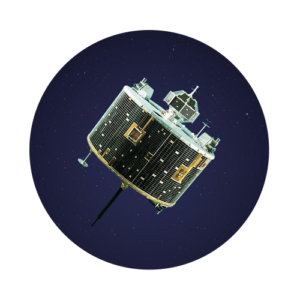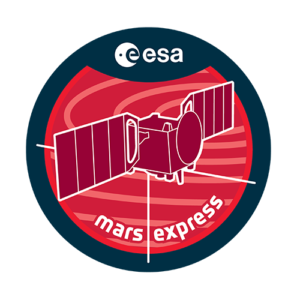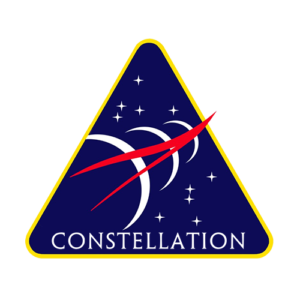Apollo 17, the final mission of NASA’s Apollo program, holds significant importance in space exploration history. Launched on December 7, 1972, it aimed to further our understanding of the Moon’s geology and environment while conducting scientific experiments.
The mission’s crew, Eugene Cernan, Harrison Schmitt, and Ronald Evans, made critical contributions to lunar science and exploration, demonstrating NASA’s commitment to pushing the boundaries of human exploration beyond Earth.
Related Content:
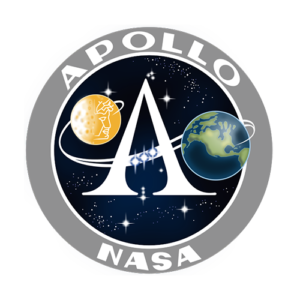
The Apollo Space Program
Explore the iconic Apollo spacecraft, which made history by landing humans on the Moon and returning them safely to Earth.

All The Apollo Missions In Order
Explore all the Apollo missions, their goals, spacecraft, and how they fared. The complete list including Apollo 11, 13, and 17.
Mission Objectives
The primary goal of Apollo 17 was to conduct extensive geological surveys and collect lunar samples from the Taurus-Littrow region. Specific objectives included deploying scientific instruments, conducting extravehicular activities (moonwalks), and studying lunar geological formations to unravel the Moon’s history and composition. Additionally, the mission aimed to demonstrate advanced spacecraft systems and technologies for future exploration endeavors.
Launch and Deployment
Apollo 17 was launched atop a Saturn V rocket from Kennedy Space Center in Florida on December 7, 1972. The launch proceeded smoothly, with no major issues encountered during ascent. The Lunar Module “Challenger” and the Command Module “America” successfully reached lunar orbit, where the crew prepared for descent to the lunar surface.
Achievements and Discoveries
Apollo 17 achieved several significant milestones, including being the only Apollo mission to feature a geologist-astronaut, Harrison Schmitt, on the lunar surface. The crew conducted three extravehicular activities, collecting over 110 kilograms of lunar samples and deploying scientific instruments such as the Lunar Surface Experiments Package (ALSEP) and the Lunar Roving Vehicle (LRV). These efforts provided invaluable insights into the Moon’s geological history, including evidence of volcanic activity and the discovery of orange soil.
Apollo 13's TImeline
December 7, 1972: Launch of Apollo 17
The Saturn V rocket carrying the Apollo 17 spacecraft, with astronauts Eugene Cernan, Harrison Schmitt, and Ronald Evans onboard, is launched from Kennedy Space Center in Florida.
December 10, 1972: Lunar Orbit Insertion
Apollo 17 enters lunar orbit after a journey of approximately three days. The spacecraft completes Lunar Orbit Insertion (LOI) to prepare for the lunar landing.
December 11, 1972: Descent to the Lunar Surface
The Lunar Module “Challenger,” carrying Cernan and Schmitt, separates from the Command Module “America” and begins its descent to the lunar surface in the Taurus-Littrow valley.
December 11-14, 1972: Lunar Surface Operations
Over the course of three days, Cernan and Schmitt conduct three extravehicular activities (moonwalks) on the lunar surface, deploying scientific instruments, collecting samples, and conducting experiments.
December 14, 1972: Lunar Ascent
After completing surface operations, Cernan and Schmitt return to the Lunar Module and ascend back to the Command Module, leaving behind scientific instruments and collected samples.
December 14, 1972: Return to Earth
The Command Module, with Cernan, Schmitt, and Evans onboard, begins its journey back to Earth after completing lunar orbit operations.
December 19, 1972: Splashdown and Recovery
Apollo 17 splashes down safely in the Pacific Ocean, approximately 6.5 kilometers from the recovery ship USS Ticonderoga. The astronauts are recovered by helicopter and brought aboard the ship, marking the successful completion of the mission.
December 19, 1972: Post-Mission Debriefing
The Apollo 17 crew undergoes debriefing and analysis of mission data, sharing their experiences and findings from their exploration of the Moon’s surface with NASA scientists and engineers.
Spacecraft and Instruments
Spacecraft
- Command Module “America“: Served as the primary living quarters and control center for the crew during lunar orbit and return to Earth.
- Lunar Module “Challenger“: Transported astronauts Cernan and Schmitt to the lunar surface and provided a temporary habitat during surface operations.
Instruments and Equipment
- Lunar Roving Vehicle (LRV): A four-wheeled electric vehicle used to transport astronauts and equipment across the lunar surface, enhancing mobility and exploration capabilities.
- Apollo Lunar Surface Experiments Package (ALSEP): Deployed on the lunar surface to conduct various scientific experiments, including measuring seismic activity, temperature, and solar wind flux.
More Apollo Missions

The Apollo 7 Mission
Apollo 7, the first crew mission of the Apollo program, launched on October 11, 1968, marked the successful return to crewed spaceflights.
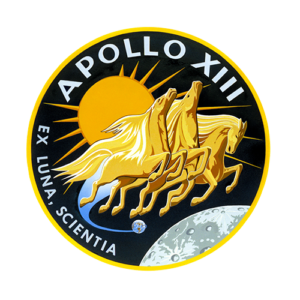
The Apollo 13 Mission
Learn about the Apollo 13 mission, intended to be the third crewed lunar landing mission in the Apollo program.

The Apollo 1 Mission
Apollo 1 was intended to be the first crewed mission of NASA’s Apollo program, aimed at landing humans on the Moon.
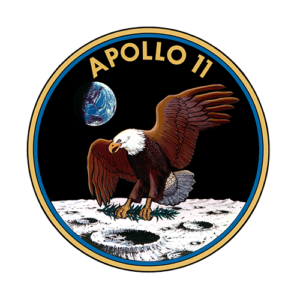
The Apollo 11 Mission
Explore the historic Apollo 11 mission, humanity’s first crewed lunar landing, marking a monumental achievement in space exploration.
